

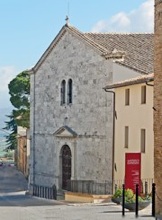
Earlier Franciscan Convents
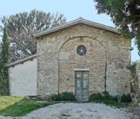
The friars subsequently moved to a new site outside Porta San Clemente, near the moat that surrounded what was then the “castrum Cocoroni”. They built a new church, which was dedicated to SS Filippo e Giacomo, and an adjacent convent, using funds raised through a series of indulgences granted:
-
✴in 1275, by Fra. Tommaso, the Franciscan papal vicar in the Duchy of Spoleto;
-
✴in 1291, by Pope Nicholas IV; and
-
✴in 1301, by Cardinal Napoleone Orsini, the papal legate.
The friars were documented in this new convent in 1306.
In 1318, witnesses to the sanctity of St Clare of Montefalco were formally interviewed here during the canonisation process. Her brother, Fra. Francesco di Damiano, was among them: he had been a friar here before his elevation as Provincial Minister in Umbria in 1316.
In 1335, Montefalco briefly joined the Ghibelline rebellion led by Pier Saccone Tarlati di Pietramala. In the following year, the brothers explained to Pope John XXII that Porta San Clemente had been closed for some three months during this period. They therefore sought his help in finding a more secure and convenient site within the walls on which they could build a new church and convent.

San Francesco
The Franciscans used the money they received to begin the construction of the present church and convent, on the site of the ancient church of Sant’ Egidio. The cloister was recorded in 1358, although nothing survives of this original structure.
The first recorded miracle of St Bridget of Sweden occurred in San Francesco, shortly after her death in Rome in 1373, as her children took her dead body back to their native country, and stopped en route here. The children did not wished to speak to a hermit who had been among her devoted companions, but her body rose from its bier and embraced him, signalling to them to do the same. Bishop Galardo of Spoleto initiated the process for her canonisation in the presence of Gomez Albornoz, the Rector of the Duchy of Spoleto and Corrado Trinci. Pope Boniface IX canonised her in 1391.
St Bernardino of Siena preached at San Francesco in 1425.
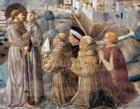
) to execute a number of frescoes for this church, which were executed in 1451-2. (This detail, in which Fra. Jacopo is depicted, is from one of these frescoes the apse.) The new campanile was built against the right-hand apsidal chapel in 1485.
Plans were made for the re-modelling of the church in 1787, but these came to nothing because of the French invasion two years later. Some moveable works of art were removed from the church in 1789 and in 1811, but much more was lost when the complex passed to the Commune in 1860 (see below). The church was deconsecrated and abandoned at that time.
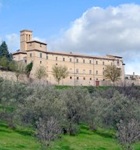
Exterior
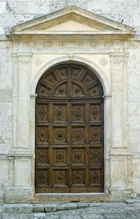
The bifore window above was added in 1876, when the façade was restored.
Interior
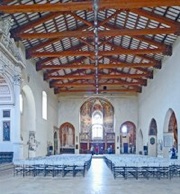
The church originally had a single nave, with a polygonal apse and square apsidal chapels. The chapels on the right were added during the restoration of 1481. The original choir screen was demolished in 1562. They were interconnected in the 17th century to form an aisle.
Clemente Bontadosi commissioned the Cappella Bontadosi (1589) off the left wall (partially visible at the extreme left in the photograph above).
The art from the church that survives in situ is described in the page on the Pinacoteca.
Art from the Church
Polyptych (14th century)
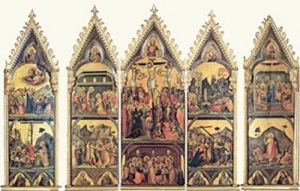
This polyptych was documented in 1771 in the right aisle, by which time it had already been cut into three parts. It seems likely that it had originally formed the dossal of the high altar of the church, and that it had been removed in 1562, when the choir screen had been demolished. Its components were documented again at the time of the French invasion of 1798.
The panels were subsequently unrecorded until 1973, when Roberto Longhi published details of a dossal in the Pinacoteca Vaticana that he attributed to the Maestro di Fossa. Silvestro Nessi (referenced below) recognised that the panels matched the 1771 description. They are now in the Vatican Palace.
The panels depict (from the top left to bottom right)
-
✴First panel:
-
•St Luke;
-
•Ascension of Christ;
-
•Lamentation;
-
•SS Paul and Francis;
-
✴Second panel:
-
•St Matthew;
-
•Christ washing the feet of the Disciples;
-
•Capture of Christ;
-
•SS Catherine of Alexandria and Nicholas of Bari;
-
✴Central panel:
-
•Christ the Redeemer;
-
•Crucifixion, with St Francis at the foot of the cross;
-
•Last Supper;
-
✴Fourth panel:
-
•St John;
-
•Christ in the Garden of Gethsemane;
-
•Road to Calvary;
-
•SS Peter and John the Evangelist;
-
✴Fifth panel:
-
•St Mark;
-
•Pentecost;
-
•Resurrection;
-
•SSLouis of Toulouse and Clare.
Crucifixion and Scenes from the Passion (14th century)
This panel has a similar history to the polyptych above:
-
✴it was one of documented in San Francesco (on the Altare del Nome di Gesù) in 1771;
-
✴it was documented again at the time of the French invasion of 1798, although by then the second panel had disappeared;
-
✴it was subsequently unrecorded until 1973, when Roberto Longhi published details of a panel in the Pinacoteca Vaticana that he attributed to the Primo Maestro di Santa Chiara di Montefalco; and
-
✴Silvestro Nessi (referenced below) recognised that matched the 1771 description.
The panel is now in the deposit of the Pinacoteca Vaticana.
Madonna of Humility with saints (ca. 1452)
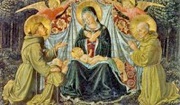
This undocumented panel in Kunsthistorisches Museum, Vienna, which depicts the Madonna and Child seated in a meadow with SS Francis and Bernardino of Siena, is attributed to Benozzo Gozzoli on stylistic grounds. The Franciscan donor portrayed in the panel is almost certainly Fra Jacopo da Montefalco, who was also portrayed in the frescoes that he commissioned from benozzo Gozzoli for the apse of San Francesco. It seems Fra Jacopo commissioned the panel while Benozzo was working on the frescoes here.
Madonna and Child with saints (1516)
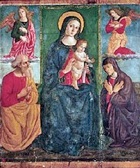
The panel was expropriated in 1811 and, on its return from France, was placed in San Salvatore in Ossibus (now San Pietro in Borgo), Rome. It was restored in 2006 and placed on the main altar of the Cappella del Governatorato dello Stato in the Vatican Palace. It is not available for public viewing.





